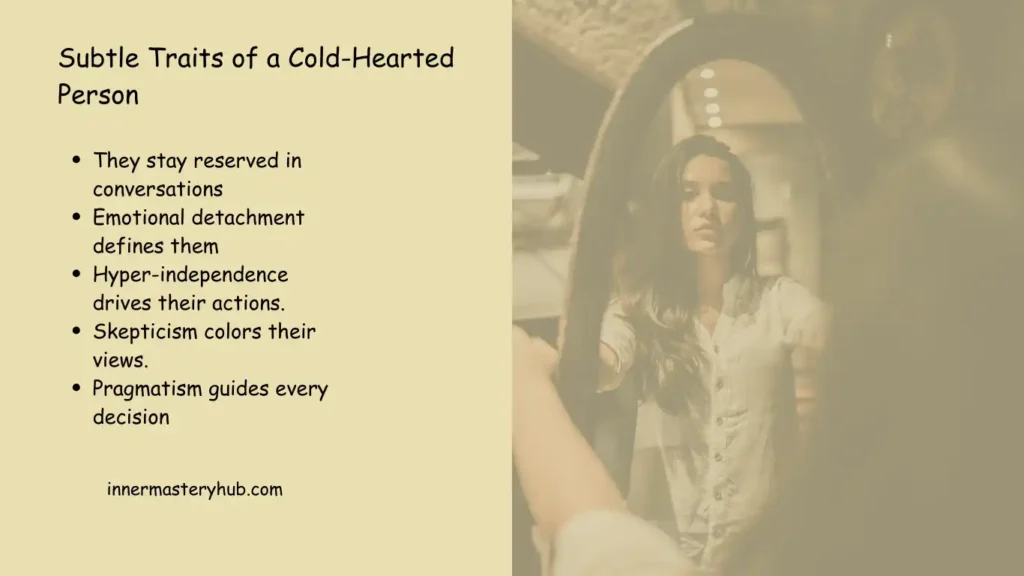12 Traits of a Cool Person—No Hype, Just What Works

Are you curious about what makes a person unique, captivating, and easy to endorse? In an age where highlight reels and hot takes are idolised, the actual traits of a cool person are grounded confidence, emotional intelligence, and everyday compassion rather than designer brands or the perfect soundtrack. Cool people don’t chase the room; they calm it. They listen more than they talk, set boundaries without drama, and carry themselves with a quiet ease that makes others feel seen.
Traits of a cool person at a glance: the six core traits (extroverted, autonomous, adventurous, open, powerful, hedonistic)
The six characteristics—social energy, self-direction, willingness to make an effort, curiosity, agency, and a healthy taste for happiness—are consistently present across cultures. While “cool” and “good” are not the same thing, capability is somewhere in the middle. Please choose one of your two natural strengths, then work on it with little daily repetition.
Extroversion—engage in a fresh conversation; autonomy—say “no” and provide a substitute; adventurousness—learning a new skill for ten minutes; Openness—before expressing your opinion, pose one intriguing query; Agency—do one duty from start to finish; Hedonism- plan one easy, widespread joy.
Traits of a Cool Person are not about Hype.
1) Warmth paired with competence is the foundation
Warmth and expertise are a magnet. You can sense it when someone remembers your child’s name, looks you in the eye, and shows they can help. Leading with warmth alone runs the risk of making you popular but untrustworthy when it comes to actual responsibilities. People may respect you yet keep you at a distance if you lead just with competence.
You become the dependable presence that people are looking for if you combine them. This is supported by decades of research on social perception: people make snap judgements based on these two factors, and the sweet spot lies in both being high.
Greet first, ask one genuine follow-up question, and then be clear about what you can do and when. If you promise, make sure you deliver it. If you can’t deliver, say so early. The “cool” effect shows up when your care matches your craft.
2) You earn status through service, not force
People can go up the social hierarchy in one of two ways: loudly or generously. I’ve tried both. Attention is gained by the first, and trust is earned by the second. Instead of “dominance,” which is control by force, cool people gravitate toward what scholars call “prestige”—influence that others willingly confer because you’re fair and helpful.
Every circle you enter, from boardrooms to group chats, reflects this difference. You can build enduring respect by teaching and mentoring without pretence and by accepting responsibility when things go wrong.
3) You listen in a way that changes how people feel
Most of us believe we pay attention. I thought I did, until a friend who was better than I was repeated what I had said. I realised then that active listening is about making the other person feel understood, not about nodding while you wait to speak. With brief reflections, open-ended questions, and a composed pause before responding, you convey that.
Genuine listening stimulates the brain’s reward systems and builds trust. Being around good listeners literally makes you feel better and is undoubtedly regarded as more influential. The next time someone complains, give one statement that sums up what they said in essence rather than offering advice. Observe their shoulders lowering. Being a Cool person isn’t about being clever; cool is calming.
4) You use humor to connect, not to compete
Being a cool person to laugh with, not at, in challenging moments, you find the brightness in them. Humour is social glue because it conveys adaptability and makes others feel secure in your presence. It makes sense—you remember those who give you a breath of fresh air, pleasant humour, and shared laughter, for attractiveness and deeper social bonds. Be kind—warm humour compounds; the cruel joke aged poorly and lands quickly.
Start small if humour seems risky, such as making fun of yourself for something trivial that you really don’t mind or making a light-hearted remark about the environment you both share. The purpose is to remind everyone—including you—that life is more than just an exam.
5) You practice the growth habit
When you think you’re done, people can feel it. When you’re learning, they can feel that too. One of the most attractive traits of a cool person is the refusal to stagnate. You don’t react when you ask for comments. You experiment in public.
You allow others to observe your progress. The idea that abilities develop with work and smart strategy is an example of a growth mindset in action; it’s associated with resilience, improved learning, and a greater likelihood of accepting difficulty rather than running away from it.
Make it real by choosing a skill you’ve silently ignored, such as public speaking or design fundamentals, and setting a small daily goal. Inform a pal that you’re going to do it. In the open, traits of a cool person grow.
6) You’re generous in ways that actually help
I used to believe that being generous required expensive actions. Subsequently, I discovered that one of the best traits of a cool person was giving in helpful ways, such as through introductions, meeting notes, politely providing clear comments, and teaching time. This kind of prosocial behaviour benefits others and is associated with improved well-being and, eventually, a more positive reputation.
People remember the people who helped them along the way, and communities support those who help others. Take ten minutes each week to start. Ask one individual, “What would make this easier?” Do it if you can. Refer them to someone who can if you are unable to.
7) Fun done right: hedonism vs. recklessness
When it’s safe and shared, fun communicates healthy traits of a cool person; carelessness burns tomorrow for a short hit today. Choose micro-risks with barriers—open-mic minutes, sunrise treks, beginner classes, low-stakes game nights. Keep simple guidelines (leave on time, watch out for friends, guard sleep), use warm humour that involves people, and your enjoyment of fun reads as maturity rather than anarchy.
8) You show humility without shrinking
Here’s a quiet power move: admit what you don’t know and give credit freely. You won’t lose face; you’ll gain followers. Humility isn’t self-erasure. It’s about your accuracy with your limits and your curiosity about others’ strengths. In teams, humble behavior shown by the person with influence improves how people feel and perform. You can model that even if you’re not the manager: ask for input, thank people for saving your time, and change your mind when better opportunities show up.
You can test this today: in your next meeting, say, “I might be wrong—what am I missing?” Then use what you hear. Being a cool person doesn’t always mean being right; they need to get it right.

9) You keep promises to your future self for being a cool person
Discipline isn’t flashy, but it’s magnetic. When you honor your own systems—sleep, exercise, basic money hygiene—you walk into rooms with steady energy. Others feel that steadiness. It’s been seen that brilliant people who couldn’t land their ideas were always running late, constantly tired, and scrambling.
Being a Cool person budgets energy, so your presence is focused. You don’t have to master every habit. Pick the one lever that makes others easier. For me, it was setting a phone-free last hour before bed. That one change made my mornings calmer, my replies clearer, and my patience longer. People notice calm in the way they see a good scent.
If you want a starter plan: set a bedtime for 5 nights in a row, block your first 90 minutes for deep work, and prep tomorrow’s “three musts” before you log off. The right kind of boring activity can free you to be more alive in the moments that matter.
10) You carry grateful attention into your relationships
Gratitude isn’t a wall poster. It’s a technique that improves your perception of those around you. You change the atmosphere when you take a moment to write down what’s working and then speak it aloud. You remind yourself that you’re not alone, you make pals more open, and you make teammates less defensive. Gratitude journaling has been linked with improved mood, sleep, and even greater exercise, indicating that this habit leads to other wise choices.
11) You say less, mean more
Talking too much doesn’t make you look cool. There’s no need to fill the void. You must make your signals fit your sentences, and your words have some cost. When you boast, talk about the team. If you request time, keep it safe.
Identify the steps you’ll take to correct any mistakes you acknowledge. Your ideals, tone, and schedule should all be in harmony for the purest form of charisma. People will cease speculating about you when you state that you cherish your family and then show up for the game on time. With the way you walk, you’ve already told them.
12) You make room for other people’s shine
The performer who knows where the light should go is frequently the coolest person in the room, not the star. Every day, you may be that person in small ways: welcome those who are more reserved early, give credit to those who provide ideas, and show that success need not be limited.
The frequency with which that kindness comes back will astonish you. Those who elevate others tend to be elevated by social structures. Your “brand” becomes apparent over time: you are the one who makes good things—and good people—bigger.
How to put the traits of a cool person into practice this week
You don’t need a complete life overhaul to look like a cool person. Choose one trait for each weekday and run a small experiment.
Monday: open with warmth—learn one personal detail and remember it. Then state clearly what you’ll deliver by the end of the day.
Tuesday: find one place to swap push for service. Share a resource or do an unasked-for helpful task.
Wednesday: In your longest conversation, reflect on the key point before you respond.
Thursday: add a dash of kind humor to ease tension in one moment you usually grit your teeth through.
Friday: send a specific thank-you message that names the impact.
Weekend: pick a growth habit (10 minutes on a skill you’ve been avoiding) and set up a tiny plan for next week. Keep your promises to your future self by protecting sleep and a short planning block. Then repeat, adjusting as you go.
Why these traits work
Social safety runs through all of these traits of a cool person. When people know you’re capable, that you care, and that you’re not trying to take advantage of them, they feel more at ease with you. This explains the effectiveness of the warmth-plus-competence blend, the superiority of the prestige path over dominance, the deep effect of listening, and how appreciation changes our interactions with one another. It isn’t abstract; instead, it aligns with your most fulfilling relationships and unified teams. People who make us feel daring enough to grow and safe enough to be ourselves are the ones we are drawn to.
FAQs About Traits Of a Cool Person
What are the top traits of a cool person?
Most readers expect the six big ones from recent research: extroversion, autonomy, adventurousness, openness, power/agency, and a healthy taste for fun—plus practical add-ons like authenticity and calm.
Can you look like a cool person even if you’re introverted?
Yes—autonomy, openness, calm, and authenticity scan as cool on anyone. The “extroversion” piece is about social energy; you can express presence without being loud.
Is “Good” the same as being a cool person?
Not exactly. Being a cool person overlaps with goodness (competence and warmth), but the study shows they’re distinct constructs.
How do I look like a cool person without trying too hard?
Prioritize autonomy, authenticity, and calm signals; do useful things; let style follow function; and speak less but mean more. Listicle patterns on page one echo these behaviors.
What daily habits make someone look like a cool person?
Show up on time, keep promises, handle stress quietly, and shine a light on others. These habits repeatedly appear in high-performing list posts.
Does sense of humor matter to look like a cool person?
A lot. Warm, inclusive humor boosts likability and social glue across guides and advice columns.
How can I build autonomy in small steps?
Set boundaries around your time, make clear decisions, and own your choices—behaviors that read as self-directed—the research finds that autonomy is a global trait of being a cool person.
Is “being a cool person” just a matter of fashion and trends?
Trends help, but the durable signal is behavior: agency, openness, and calm risk-taking. That’s what both studies and timeless advice underline.
What’s the difference between confidence and arrogance?
Confidence pairs agency with openness and warmth; arrogance skips openness. Readers reward grounded competence and service.
Do cultural differences change what it looks like to be a cool person?
Less than you think. A multi-country sample found surprising agreement on the six core traits—though expression can vary across scenes and subcultures.






